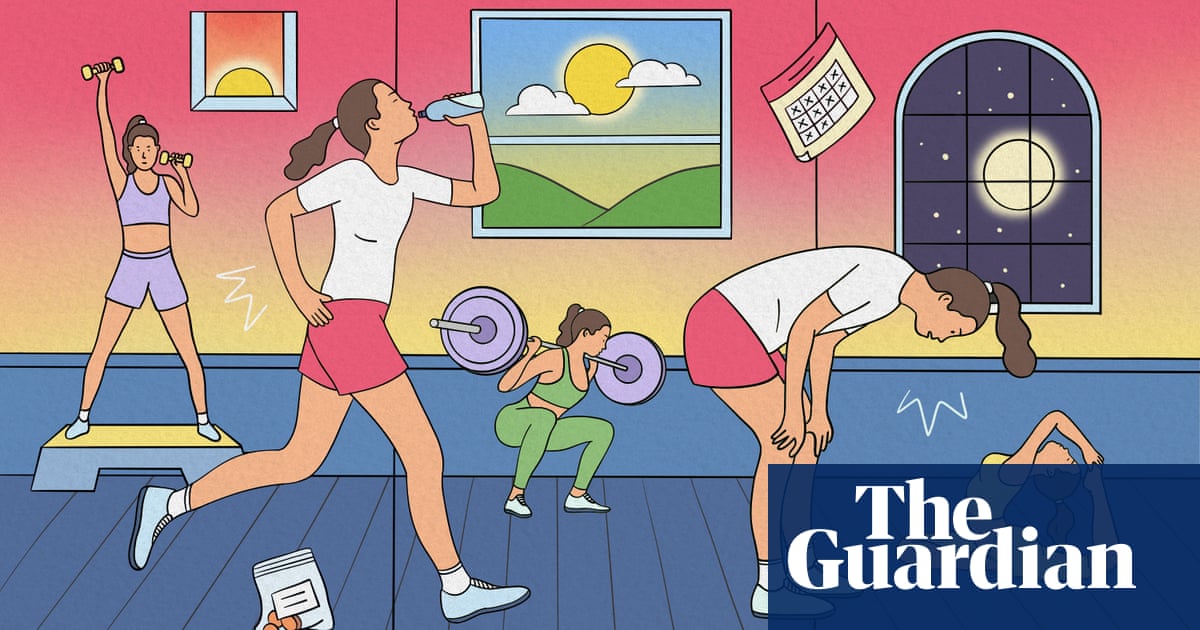When I was a young drug and alcohol addict with a raging eating disorder, I would periodically decide to get myself together by getting in shape. I would go to my local gym in New York and attempt to run on the treadmill, then make myself do leg raises until my abs were tender to the touch.
These gestures toward fitness were feeble; I never stopped smoking Camel Lights and always quit after a few sessions anyway. But I had already absorbed from diet and wellness culture the idea that I would become “better” if I became fit, so when I felt my messiest – bloated from bourbon, out of control with heroin and pills, eating huge quantities of diner food and vomiting it up until my throat bled – I looked to fitness as a beacon.
After I got sober, I began working a physically demanding job as a metalworker. I grew strong, but I remained unhealthy, smoking, starving myself, and eating bodega food. I lived in my body as a hostage lives in a room.
Then, in my late twenties, I tried for what felt like the millionth time to go for a run, and something had changed. Not physically – I was still a mess, which my running log shows (ran to Target – about a mile away – threw up, walked home). But for the first time, I was able to remain in the discomfort and find the willingness to keep going.
Within a few months, I was clocking 10 to 15 mile runs across all the bridges to Brooklyn, up and down the West Side Highway esplanade, around and around Central Park or Prospect Park. I could run, and far, and I became obsessed with testing how far I could go. My body grew harder and more taut, as I’d always desired, and my feet peeled apart in bloody layers.
I didn’t realize the running was not about fitness, sport or even physicality. I was not out there just to be an athlete. I was out there to see how hard I could push myself, and to carve out a space to disappear into.
The first time I used the phrase “exercise addiction” was in a piece of writing. I was in my thirties, enrolled in an MFA program but cognitively fried from the effects of the seven daily hours I was spending working out.
By then, I had three gym memberships, three coaches (one of whom I kept secret from the other two to avoid conversations about overtraining), and standing appointments at a long list of group fitness classes. I was constantly training for marathons, I was lying to friends about how much I was exercising, and I was in too much pain to sleep at night or walk properly. I lived on tins of sardines, whole avocados and cans of coconut cream.
As they say in recovery fellowships, I was skidding along the bottom.
It felt so stupid saying “exercise addiction” that I redacted it from my essay before submitting to my writing workshop. I thought people would laugh at me because I wasn’t exercising enough to have earned the distinction of being called an addict.
I spent my days rushing from one gym to another and gobbling cold slices of sweet potato out of Ziploc bags in between workouts. During this period of my life, I received more non-sexual positive feedback on my body than I ever have before or since. At the gym, at the grocery store, on campus, at yoga and on social media, people approached me to tell me how strong I looked, how jacked I was. They asked what I did for workouts, what I ate, if I would train them. They looked at me with what I can only describe as admiration.
This was also when I met my partner, a professional strength and conditioning coach who trains elite athletes.
“Babe,” I asked him recently, “do you think I had an exercise addiction when we met?”
This man – someone I have watched lift over 400lbs in flip flops – laughed in response, shaking his head at how obviously the answer was yes.
What was most confusing about those years was that, to my understanding, I was doing everything right. I was getting all my steps in, doing Hiit and weight bearing exercise, avoiding processed foods and sugar. According to the Instagram wellness influencer metric of health, I was doing great. So when symptoms like missed periods, chronic pain, deep episodic exhaustion and insomnia cropped up, I figured I just wasn’t doing enough, and I tried to do better – which to me meant doing more. I added in more yoga and a night treadmill run; I cut seed oils out of my diet.
It did not once occur to me that doing too much might be the source of my problems.
In addiction medicine, there’s no consensus on what exercise addiction is. It isn’t mentioned in the American Society of Addiction Medicine textbook, and, like many behavioral addictions, it isn’t named in the DSM-5. But when I talked to addiction psychiatrist and bioethicist Dr Carl Erik Fisher, he told me: “My own experience as a clinician is that behavioral addictions are important phenomena. Many people suffer from them, and they deserve to be taken seriously.”
Like many behavioral addictions, there simply isn’t enough quality research on exercise addiction or compulsion for doctors – who are, after all, scientists – to make firm statements about what it is, how it happens to a person, and what you might do about such a thing.
I’d been attending 12-step recovery meetings for a decade and a half for the “real addictions” I got sober from in my twenties. As my mental and physical health deteriorated, I began obliquely sharing some new concerns.
“I think I have a problem with the gym,” I said at my regular weekly meeting. I felt absurd – like I had complained that I had too much money. Everyone wanted to go to the gym more often. How could it be a problem? After the meeting, a woman approached me to comment on my share. “I wish I could have that one,” she lamented, pulling on a vape. “You look great.”
“Thanks,” I said, softly. “But I don’t feel good.”
Over the following months, I discovered that in 12-step culture you can talk about having a troubled relationship with drugs, alcohol, food, sex, relationships, money, work, shopping and even crime, and people Get It. Either they relate to the particulars, or they can extrapolate from their own difficulties to conjure some empathy for yours. But exercise? Not so much. People didn’t understand how exercise could be an issue, or they were, by their own admission, jealous, or they failed to grasp the extent of what I was doing with my body.
Even my therapist just suggested I shift gears from lifting to yoga, as if my athletic programming rather than my mental health was the issue. I had the strong sense she was out of her depth. I had also groomed my friends to accept the persona I had carefully built: a little unhinged but in a fun way, always on the way to the gym. I was able to hide the extent of my unmanageability, and I stopped trying to talk to anyone about my growing suspicion that athletics had become yet another thing I had lost control of.
Groping for language to describe an experience that was becoming increasingly unmanageable, I found few resources. The conversations I tried to initiate with various doctors were useless at best, dismissive at worst. I was repeatedly told to just exercise less, as if I were not smart enough to understand that to be the sensible course of action.
“In medicine, there’s a problem with being comfortable with the grey areas, the unknown. Providers feel inadequate when they don’t know and don’t have data, and project that as frustration,” says addiction medicine physician Melody Glenn, MD. “DSM-5 doesn’t recognize exercise addiction, because there is a lack of research on the topic.”
But here’s what I do know: I exhibited every single one of the criteria cited in the paper Exercise dependence: a systematic review, for Psychology of Sport and Exercise which are modifications of the DSM criteria for substance use disorder: tolerance, withdrawal, lack of control, intention effects, time, reduction in other activities, and continuance.
My partner was the only person who saw most of what was going on. My problem was of a variety he had encountered professionally, and he recognized it for what it was: a psychological problem manifested through physical actions, which in habituation became a physiological condition. Fitness, for me, began as a pursuit of aesthetics, but I quickly learned it was actually the pursuit of power over myself. The weight I could lift or the speed I could move at was just a measure of how much I could push myself. Only in the gym or on the track have I ever felt fully in control of myself, and it was intoxicating.
I didn’t like him seeing my dysfunction. I wanted him to see my eight visible abdominal muscles, my six-and-a-half-minute mile and my two-hundred-pound squat and think I was hot and awesome. But he saw me unable to take a rest day, wobbling into the gym unable to lift because I had already worked out too much, spiraling into depression after an injury. He was too close, and too wise, to hide from.
I have been addicted to many things, and of all of them, finding myself strung out on athletic training was the stealthiest and the most confusing to recognize and deal with. I overtrained myself into acute and chronic injury, adrenal fatigue, chronic illness, deep exhaustion, mental illness, mania and despair.
I also didn’t properly “recover” the way I have from the other things I’ve leaned on too heavily to order my life. Unlike drugs and alcohol, eating disorders and depression, I never went to treatment or therapy specifically for my exercise addiction. The 12-step abstinence model didn’t fit, because I didn’t want to abstain from movement. I briefly tried cognitive behavioral therapy, the gold standard for treatment of behavioral addictions, and found it overwhelming. The only thing that worked was allowing the situation to unravel to the point that I could not tolerate its consequences.
I rarely speak of my problem with exercise, and it wasn’t until I published my book, Brutalities – in which I explore my lifelong fascination with physical extremity, including exercise – that I acknowledged it publicly.
Part of the reason for this silence is that I don’t always feel entirely recovered from it; in my head, it’s still there, most days, as background noise in my head.
“It’s weird, being a potato person,” I said to my partner recently, by which I meant someone without visible musculature or tangible evidence of athleticism – literally a person the shape and consistency of a baked potato. “Babe,” he said to me, with a sad look on his face, “you look like an athlete.” I take him at his word, because he is honest to a fault and assesses my body with a professional’s neutral gaze. His impression isn’t clouded like mine is. But I don’t see any of it, because I am not strong like I once was, and I feel, in my regular-person body, too small and too weak and too slow, a person lacking the power I once had.
When I look at videos of myself lifting during the year I was strung out on the gym, I see how strong I was. I also remember how weak I felt, and how many hours I made myself train in the pursuit of getting stronger. I don’t think I ever fully enjoyed my power when I had it, which to me is the saddest part of the whole thing.
Like many of my addictions, I let go of overexercise only when its damages became intolerable. When my chronic illness, exacerbated by overtraining, threatened first my fertility, then my pregnancy and then my ability to parent my child, I became able to behave reasonably in a way I had not been before.
That doesn’t mean I’m fully recovered, or particularly comfortable. These days, I train three or five days a week, for 30 minutes or an hour. I try to listen to my body, to not train if I’m not feeling well. I am not fast or strong like I used to be – there’s nothing special or extreme about the way I work out. I’m just out here trying to preserve longevity and keep my bones and heart healthy like everyone else.
On my hands, I feel with the pad of my thumb for the barbell callouses that used to sit like hard jewels at the bases of my fingers. Like little ghosts of who I used to be, they are barely there.






